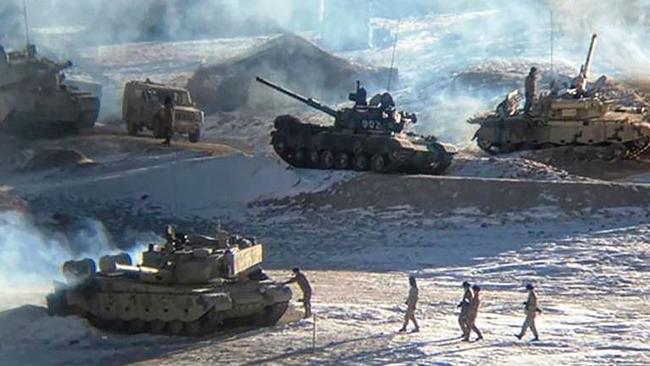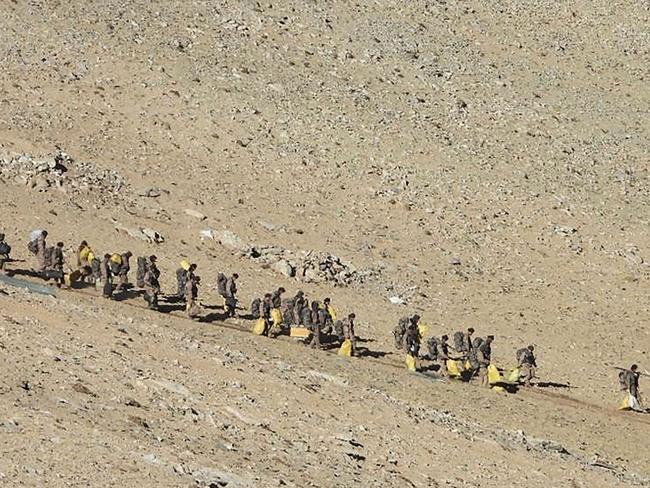China removes tanks and dismantles helipad, easing border tension with India
China is on track to disengage from one of the three flashpoints of its border dispute with India, although some in New Delhi remain sceptical about the agreement.

China is on track to disengage from one of the three flashpoints of its border dispute with India, which was the site of deadly clashes last year between the two nuclear powers.
The People’s Liberation Army has withdrawn more than 200 battle tanks from land around the contested Pangong Lake, dismantled a helipad and is taking down tents, observation posts and a makeshift hospital, according to reports in the Indian press.
The de-escalation at one of the most militarised sites on the long-disputed 3440km mountainous border — called the Line of Actual Control, or LAC — indicates the Chinese side is honouring a withdrawal deal revealed last week.
But some Indian security experts remain sceptical about the agreement.
“Although significant, this deal by itself is unlikely to ease tensions,” said Brahma Chellaney, a New Delhi-based foreign affairs expert with hawkish views on China.
“The Pangong Lake deal shows that China is leveraging the land grabs it made stealthily last April to impose border buffer zones that create a new status quo in its favour,” Professor Chellaney told The Australian.
A night clash between the two armies last June killed 20 Indian soldiers and an unknown number of Chinese soldiers, the first deaths on the contested border since 1975.
Prime Minister Narendra Modi’s government responded by increasing troop deployments along the border, banning video app TikTok and 58 other Chinese apps in June and thickening its security relationship with the US, Japan and Australia.

In a keynote speech on Sino-Indian relations last month, Indian External Affairs Minister Subrahmanyam Jaishankar said the PLA’s aggression had put the relationship under “exceptional stress”.
“They not only signalled a disregard for commitments about minimising troop levels, but also showed a willingness to breach peace and tranquillity,” Mr Jaishankar said.
China’s officials maintain India provoked the nine-month-long border conflict.
After months of negotiations, the two sides announced last week that they had agreed to disengage at Pangong Lake.
China’s state media has cast the withdrawal as an example of the PLA’s new strength.
“The massive withdrawal shows Beijing’s sincerity for peace and border stability, at the same time showcasing the country’s increasingly growing defence capability,” the Chinese state-controlled tabloid the Global Times reported.
“In other words, the PLA has the ability to withdraw this many forces in one day, but also can replenish that much in a single day,” the Global Times reported, citing Chinese experts.
The conflict, which has been widely reported in India, has soured public opinion towards China. Rahul Gandhi, leader of the opposition Congress party, has criticised the Modi government for not being tough enough with its increasingly powerful neighbour.
“Why has Indian territory been given to the Chinese? This is the question that the Prime Minister and Defence Minister need to answer,” Mr Gandhi said in parliament after the deal was announced.
But some analysts are hopeful that the deal — once completed in the coming weeks — could be followed by the disengagement of thousands of troops at the two other flashpoints on the disputed border: Gogra-Hot Springs and Depsang Plains.
“In the near term, the disengagement greatly reduces the chance of military escalation between two nuclear-armed powers by creating buffer zones between their frontline forces,” said M. Taylor Fravel, an expert on China’s territorial disputes at the Massachusetts Institute of Technology.
“In the longer term, it could serve as the basis for talks to reduce incidents along the LAC, especially in areas where the two countries view the location of the LAC differently,” Mr Fravel told The Australian.




To join the conversation, please log in. Don't have an account? Register
Join the conversation, you are commenting as Logout